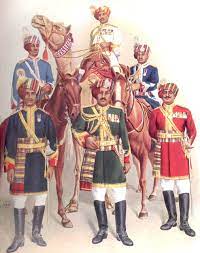The northern portion of modern-day Rajasthan which comprised regions like Ganganagar, Hanumangarh, Churu, and Bikaner was once been a part of the Rathor supremacy. The kingdom of Bikaner was the house of Rajputs belonging to the Rathore branch.

Their intruding tales of bravery, heroism, architecture, and cultural beauty embellish the everlasting history of Rajputana. Tracing its lineage from the great Rao Jodha of Marwar the Rathors of Bikaner emerged as powerful political figures during the late 15th century.
The land was initially referred to as Jangal Pradesh or Jangladesh (Jangaldesh comprised the territories of modern-day Bikaner and some portion of Jodhpur) and was the home of local tribal groups like Bhatis, Jats, etc.
To this day not much is known about the history of this precious kingdom of the Rajput which had shown their dauntless valor against the enemies like Delhi Sultanate and Mughals. Here we will delve into their forgotten past and present their tantalizing tales of glory.
Content
Rise of Rao Bika (1465-1504): The Founder of Bikaner Kingdom
Rao Bika was the sixth (11th in some texts) son of Rao Jodha and was the founding father of the kingdom of Bikaner. The early history of Bika is a little ambiguous. All that is known from the writing of the imminent historians like G.S.Ojha and Gopinath Sharma is that Rao Bika after stabilizing the kingdom of Marwar with his father left the land of Maroo with his uncle Rawat Kandhal in search of establishing his kingdom.
With a band of 500 infantry and 100 cavalry, Bika left Jodhpur and headed north in search of new land. Another story behind the foundation of the Bikaner kingdom is that in the year 1465, the region of Jangal Pradesh was invaded by the neighboring Baloch tribe.

The native people asked Rao Jodha’s aid who was the dominant power in that region. In return, the Marwar king sent his able son Bika with his brother Rawat Kandhal and both conquered the territory of Jangal Pradesh resulting in the foundation of the second house of Rathors in 1465.
Bika spent his initial days in the regions of Chudasar where he assembled his troops and strengthened his army. Later he moved to Kodamdesar and made it his capital. He also constructed a fort there and a temple dedicated to Shiva.
Note: It was in the year 1488 when Bika named his kingdom as BikanerConquests
In a few years, Bika along with his daring uncle Rawat Kandhal was able to conquer neighboring kingdoms. In a short period, his kingdom included around 3000 villages.
Later his kingdom was extended up to the Punjab border touching the territories of the Delhi Sultanate. It is also suggested that Rao Bika rescued the king of the Bhati tribe Rao Shekha. The Bhati king was attacked and imprisoned at Multan by a band of local tribes.
The queen of Rao Shekha asked Bika’s help and the spirited Rathore with his army raided Multan and freed the imprisoned king. In return, Rao Shekha gave his daughter Rang Kanwari (Kunwari) in marriage to the Rathore king.
Note: Later the son of Rao Bika and Rang Kanwari Rao Lunkaran ascended the throne of Bikaner.
Conflict with Delhi Sultanate
While Bika was busy settling the affairs at Bikaner his uncle Rawat Kandhal who aptly stood by his side extended the former’s authority in every possible direction through several military expeditions. But Rawat Kandhal’s toughest opponent was the Turks of Delhi Sultanate.
With his son, he marched on the province of Hissar which was then ruled by Sultan Bahlol Lodhi. Sarang Khan the subedar of the region readied himself to stop the army of the Rathores. Both sides met at the village of Sahwa where a fierce encounter took place. Kandhal who by now aged 70 fought gallantly against the Sultanate’s army.
However, he lost his life in this battle after putting up a tough fight. His bards of heroism are still alive in the folklore of the region and his successors were named Kandholats. When news of Kandhal’s death reached Bikaner Rao Bika assembled his forces to avenge the death of his beloved uncle.
Together with his father Rao Jodha the combined forces of the two branches of Rathors defeated Sarang Khan and his forces.
Conflict with Marwar
Rao Jodha had promised Bika that after the former’s death, the latter would inherit the royal insignia and heirlooms of Marwar. When the time came to present the precious heirloom to Rao Bika the successors of Rao Jodha refused which infuriated Bika and in return, he laid a siege on Mehrangarh fort.
It was only after the intervention of the widowed queen of Rao Jodha who fulfilled the promise of his husband and gave the royal heirlooms to the kingdom of Bikaner.
Last Expedition
Bika’s last expedition was against the alliance of the Delhi Sultanate and Rinmal.
However, he was injured in this confrontation but succeeded in subjugating the area of Rewari. The illustrious career of the first king of Bikaner was filled with glory and conquests. He greatly expanded his influence and also tackled the powerful kingdom of Delhi.
He died a peaceful death on 17 June 1504 and after him, his descendants donned the skills and valor of the Rathore blood and aptly ruled Bikaner.
LIKE WHAT WE ARE DOING? DONATE TO DHARMAYUDH
If you support what we are doing and would like to contribute to help us grow and reach more Indians to teach them more about such forgotten historic Indian Heroes and stories, please consider donating any amount. It will help us grow.

